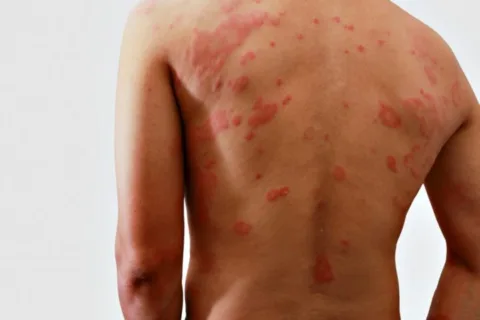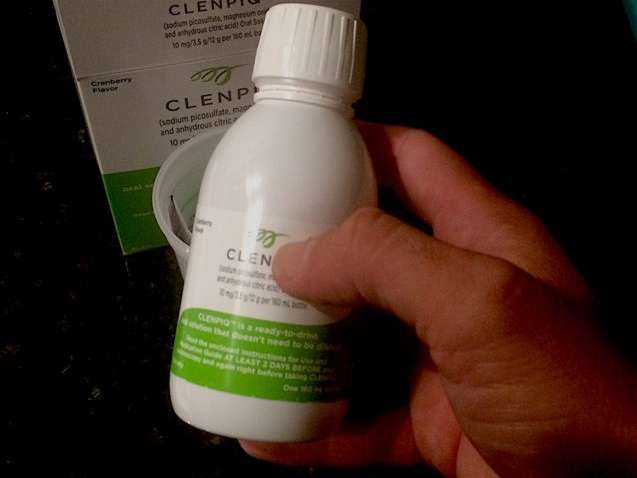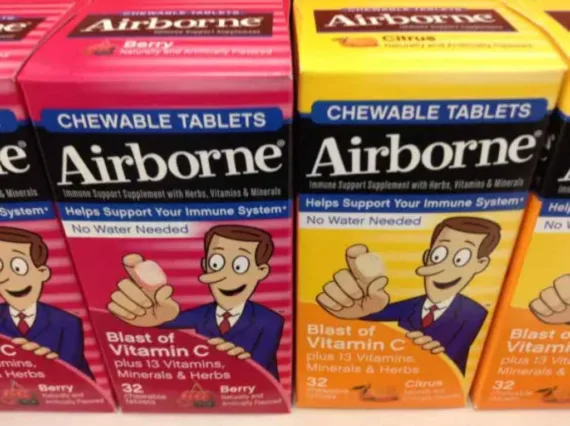Are you ready for a daunting statistic?… 1 in 3 people in the United States will develop the shingles virus at some point in their lifetime.
The notorious itching, burning, and pain of shingles will lead you into a desperate search to find a quick-acting shingles treatment.
My dad has shingles. His outbreaks are typically a result of his immune system being compromised.
For a guy that has a pretty high threshold for pain, I’m surprised at how his shingles breakouts really affect him. He breaks out in a rash, complains of severe pain, has less energy, and is very sensitive to the sun — not good for a guy who loves to go boating all summer long.
My dad manages his breakouts with medications. But if you prefer home remedies for shingles, we’ve learned that coconut oil is one of the best options for a shingles treatment. (More about that in a minute.)
In this article, you will find:
- Some things you probably didn’t know about the shingles virus.
- The symptoms you can expect and how long they’ll last.
- Whether it’s possible to get shingles twice, plus the lasting effects of having shingles.
- How to find the best shingles treatment for you, including home remedies for shingles.
- If shingles is contagious or not.
What Is The Shingles Virus?
Herpes zoster is the condition more commonly known as shingles.
Don’t confuse it with genital herpes. The 2 conditions are caused by viruses that are quite different from one another.
The virus that causes shingles is the same one responsible for Chicken Pox. In fact, shingles is actually a reactivated form of Chicken Pox.
The herpes zoster virus can lie dormant in your body for years — by hiding out in brain and spinal cord tissue. Then, one day, a very bothersome rash appears. You have shingles!
Some things you need to know about the shingles virus:
- Shingles outbreaks usually occur due to a weakened immune system.
- The virus gives you immunity to Chicken Pox. (That’s why you cannot get Chicken Pox twice.)
- It is painful and can be quite embarrassing.
- Most times, an episode of shingles will last for 3 to 5 weeks.
- Shingles can have some very negative long-term effects. (That’s why you’ll want to seek treatment for shingles very quickly.)
- Most people have only one episode of shingles — however, it is possible to have shingles more than once.
What Are The Symptoms Of Shingles?
Shingles tends to present itself in a typical pattern each time.
Here’s what to watch for if you think you have the shingles virus:
- A burning or tingling pain is usually the first symptom of shingles.
- 1 to 5 days later, a red rash will occur on some part of your body — typically it only affects small sections of your skin.
- You might also have a fever, sensitivity to light, and fatigue.
- A few days after that, fluid-filled blisters form.
- Usually 7 to 10 days after first appearing, the blisters will dry up and form scabs.
- A couple of weeks later, the scabs will go away.
Long-Term Effects Of Having Shingles
A case of shingles can be far more serious than the annoyance of the rash and persistent itch.
The condition isn’t life threatening, but it can be (and usually is) excruciatingly painful.
In addition to the month or so of pain, rash, and blisters which tend to occur when you get the shingles virus, a few other conditions can also occur:
- Post herpetic neuralgia (PHN) – which causes pain to continue for months (or years), even when the shingles rash is no longer visible. If you develop this complication, you’ll probably have to be treated with antidepressant medicines, as well as opioids, anti-convulsant medicines, and topical anesthetics.
- Disseminated zoster – which can negatively affect many internal organs (including your lungs, heart, pancreas, liver, and intestinal tract).
- Herpes zoster ophthalmicus – which can threaten your eyesight.
If the blisters from shingles appear close to the eye or occur on the tip or side of the nose, see a doctor immediately. Shingles can end up causing vision problems if it involves nerves around the eye. Source
Shingles Treatment Options
There is no cure for shingles.
The shingles treatments that are available will help to relieve the symptoms and keep the condition under control — but they won’t cure it.
Here’s a list of the types of doctors that specialize in shingles treatment.
You can manage the shingles virus with:
- Over-the-counter medications — including aspirin
, ibuprofen
, and acetaminophen
(all of which may give you some relief from the pain)
- Antiviral medicines that your doctor may prescribe — such as acyclovir, valacyclovir, and famciclovir.
- Topical antibiotics — for the blisters that result when you have shingles (antibiotic ointments will fight the infection)
- Home treatments — the list of home remedies for shingles is long, but coconut oil seems to consistently provide good results
Benefits Of Using Coconut Oil As A Shingles Treatment
Coconut oil can be used as a home remedy for many common health conditions.
As a bonus, when you use coconut oil as a treatment for shingles, you’ll be reaping the rewards of the oil’s other health-boosting properties — which may help you become an overall healthier individual.
The biggest reason that coconut oil as a shingles treatment works is because it’s a natural substance that is known to have powerful antiviral properties.
Coconut oil boosts the immune system and promotes healing in these ways:
- When coconut oil is applied directly to the shingles rash, you can expect some relief from the pain.
- When taken orally, the coconut oil helps you battle the shingles virus from inside your body, over time.
Coconut oil (virgin) is another excellent natural remedy for shingles treatment. It works as immune System Booster due to its anti-bacterial, anti-fungal, and anti-viral abilities. The fatty acids (Caprylic and Lauric) in coconut oil reduce inflammation internally and externally. You can use virgin coconut oil internally, as well as a skin ointment to treat shingles fast. Source
Here’s a great summary of how one person survived shingles and PHN by using coconut oil as a carrier oil mixed with essential oils.
Other Home Remedies For Shingles
In addition to coconut oil, there are a number of other home remedies for shingles including:
- Taking a bath – Daily cleansing of the blisters reduces the risk of spreading the infection. The coolness of the water can ease pain from shingles blisters and calm itchiness.
- Using a cool, wet compress – Do this several times throughout the day to relieve symptoms. Soak a cloth in cool water, wring out the water, and apply the cloth to the rash and blisters.
- Using a baking soda and cornstarch paste – Pour 2 parts cornstarch or baking soda into a cup and add one part water to achieve the desired consistency for the paste. Apply the mixture to your rash, and then rinse it off after 10 to 15 minutes.
- Applying lotions and creams – Lotions and creams
don’t speed up the healing process, but they can increase your comfort level. You should avoid scented or perfumed lotions though — because they can cause further irritation.
- Eating certain foods – Some dietary changes can strengthen your immune system and prevent shingles from spreading to other parts of your body. Here are some examples of what to eat (and not eat) when you have shingles.
- Trying homeopathic remedies – Some supplements and herbal remedies may also help your body fight the virus, as well as treat insomnia and anxiety due to shingles.
Just remember to talk to your doctor first before trying any home remedy as a shingles treatment.
TIP: Afraid you might get the shingles virus later? Get vaccinated now!
Approved in 2006, the shingles vaccine cuts the risk of developing shingles by about half. But even more important, it reduces the odds of lingering nerve pain (“postherpetic neuralgia,” or PHN) by 59%. PHN can be a painful nuisance well after the rash from shingles is gone. The vaccine’s effectiveness begins to wane after 5 years, but it still lowers the risk of shingles by 21% and PHN risk by 35% after 7 to 10 years. The vaccine is approved for people older than age 50, but the risk for PHN rises with age, so the CDC advises waiting until after age 60 to be vaccinated.
Is Shingles Contagious?
If you’re a friend or family member of someone with the shingles virus, you’re probably wondering about the exact shingles contagious period. (I know I was.)
Good news: Shingles is less contagious than having full-blown Chicken Pox. However, yes, it is still contagious!
To be clear, the shingles virus is spread through direct contact with the fluid from the shingles blisters. Therefore:
- If the affected person doesn’t have any blisters yet, then they are not contagious yet.
- If the affected person’s rash has developed crusty scabs, then they are no longer contagious.
With regard to shingles contagious factors, consider this:
- If someone HAS NOT already had Chicken Pox, a person with shingles could infect them with the virus — which would cause them to develop Chicken Pox. If they do get the virus, it will be with them forever, and it could later reappear again as shingles.
- If someone HAS already had Chicken Pox, a person with shingles cannot infect them — because they already have the virus in their body. If they happen to develop shingles, it would be from the virus they already had, not from contact with an affected person.





